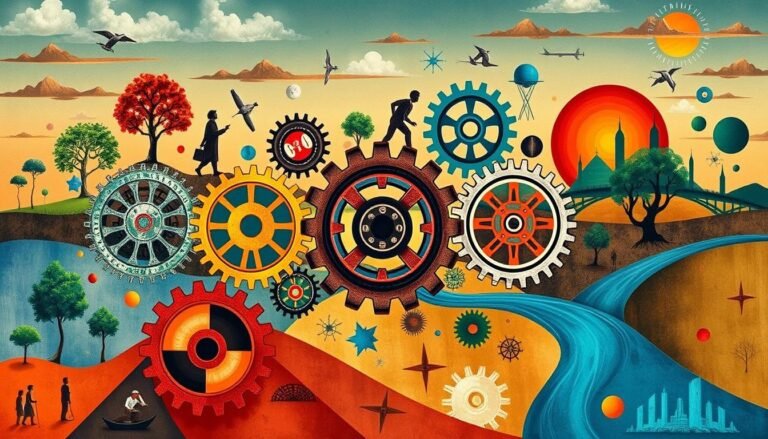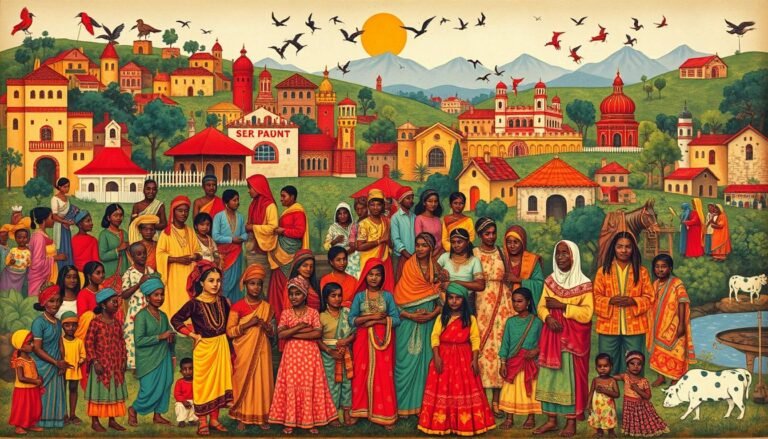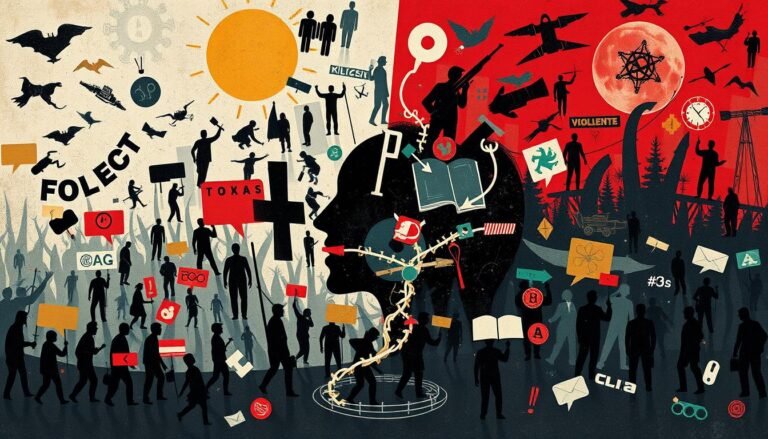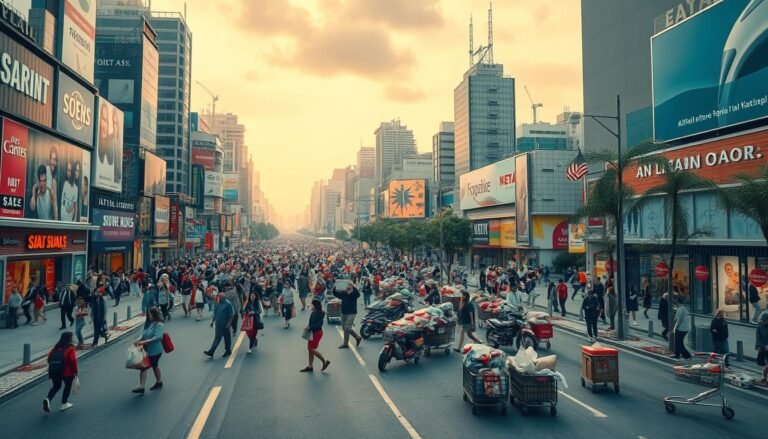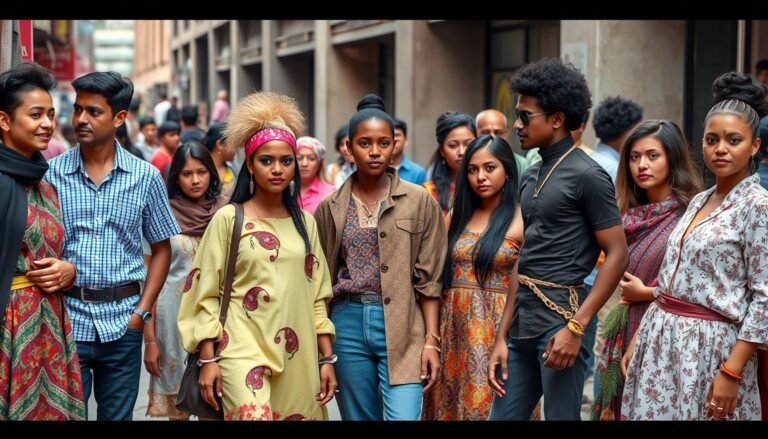Globalization and Its Impact on Local Cultures
Have you ever thought about how your favorite local dish made it to a menu far away? Or why traditional festivals now have new twists? Welcome to the world of globalization, where cultures mix and traditions blend with global trends.
Globalization has made cultural exchange complex, changing how we see identity and tradition. We see Western influences spreading fast, making us wonder about the future of local customs and values.
This topic has sparked many debates. Some see the good in sharing cultures, while others fear losing local identities. Globalization’s impact is big, affecting our food, social lives, and more.
We’ll look into how global integration is changing our world. We’ll see how tech, trade, and travel speed up cultural sharing. We’ll also talk about the good and bad sides of this new global mix.
As we delve into the effects of globalization on cultural identities and local customs, it’s fascinating to explore how traditional food adapts to global influences. For instance, the traditional food of Corfu offers a glimpse into how local cuisines preserve their unique flavors while embracing external culinary trends.
Understanding Globalization in the Modern World
Globalization deeply affects our world. It’s a complex process that links economies, cultures, and societies across the globe. Let’s look at the main parts of globalization and its big effects.
Definition and Key Concepts
Globalization means countries and cultures are becoming more connected. It’s pushed forward by new technology, trade, and ways to communicate. This change has good and bad sides for both local areas and the world.
Historical Context of Global Integration
Globalization has roots that go way back. The Triangular Trade between Europe, Africa, and the Americas is a key example. Now, it’s moving faster, touching almost every part of our lives.
Drivers of Globalization
Several things push globalization:
- Technological advancements
- Economic liberalization
- Political cooperation
- Improved transportation
These factors have made our world more diverse and changed local communities a lot.
| Aspect | Impact |
|---|---|
| Standard of Living | Increased in developing countries |
| Cost of Goods | Decreased due to global production |
| Income Disparity | Potential increase in inequality |
| Cultural Traditions | Challenged by global influences |
Globalization has its upsides like making economies grow and giving us access to more goods. But, it also challenges local cultures and traditions. Finding a balance between global connection and keeping cultural diversity is a big issue today.
The Interconnectedness of Global Economies
Global integration has changed economies around the world, making them more dependent on each other. This started a long time ago, with the Silk Road, a trade route from 50 B.C.E. to 250 C.E. Now, economic effects spread quickly across borders.
Today, economies focus more on information and ideas. This change makes the impact of economic ups and downs bigger worldwide. For example, a financial crisis in one country can affect others, showing how connected we are.
Because of this connection, cultures are blending too. Big companies bring Western ways and consumer culture to new places. This can push out local businesses and ways of life, changing communities.
“Globalization has led to increased risks for disease transmission, such as with ebola and severe acute respiratory syndrome (SARS), highlighting a downside.”
But, being connected also brings chances for sharing cultures and helping each other. Wealthy countries can help poorer ones in times of need. This connection is also seen online, with big websites like Google in 67 languages and Wikipedia in 339 languages. This helps people around the world communicate and share knowledge.
Cultural Homogenization: The Spread of Western Influence
Cultural homogenization is a big part of globalization. It means more people around the world are adopting Western culture. This includes symbols, customs, and values from the West.
Western culture is now a big part of the world market. This makes it hard for local cultures to keep their own identity.
Popular Culture and Media
Western popular culture is big in media all over the world. You can find Hollywood movies, American TV shows, and Western music everywhere. This leads to fewer local shows and music being made and enjoyed.
Fashion and Lifestyle Trends
Western fashion trends are seen all over the globe. Companies like Starbucks have grown from one store in Seattle to almost 20,000 in about 60 countries. This shows how Western lifestyle choices are becoming common everywhere, which might threaten local cultures.
Language Dominance
English is now the main language for business and tech. This can make local languages and dialects less common. People often have to learn English to talk to others worldwide, which might mean losing their native language.
| Aspect | Impact on Cultural Diversity | Example |
|---|---|---|
| Media | Reduction in local content | Hollywood dominance in global cinema |
| Fashion | Adoption of Western styles | Global popularity of jeans and T-shirts |
| Language | Decline of local languages | English as the primary language of the internet |
Some people see cultural homogenization as a bad thing. But, others think it’s good for education and making global rules. The idea of glocalization says local cultures can take global trends and make them their own. This might help keep some cultural diversity alive.
Globalization and Its Impact on Local Cultures
Globalization has changed local cultures all over the world. The internet has brought Hollywood entertainment, making local languages less popular. Brands like Coca-Cola and McDonald’s spread consumer values across the globe.
Indigenous communities face big challenges today. Most live in developing countries, and their traditions are at risk. In the Amazon, 1.7 million people from 375 groups struggle to keep their way of life safe.
Globalization both threatens and celebrates cultural diversity. Over 2000 languages and cultures might disappear, but the internet helps ethnic groups show who they are. This shows how complex globalization’s effects on culture are.
“Globalization is a double-edged sword for cultural diversity. It threatens traditional practices but also provides platforms for their preservation and celebration.”
Globalization affects local cultures a lot. A survey in seven countries showed that 48% think it has made life better and helped the economy. But, there are worries about jobs and workers’ rights. The goal is to keep improving the economy without losing cultural heritage and rights of indigenous communities.
Erosion of traditional practices and values
Globalization has changed traditional practices and cultural preservation around the world. The Silesian region shows how work, family, and religious values have shifted.
Changes in Social Structures
In Silesia, people’s priorities have changed. Now, 80% still want job security and good pay. But, 64% also want to feel fulfilled in their work. This shows a move from group values to individual goals.
Shift in Family Dynamics
Family life in Silesia is evolving. Women now see work as important, not just for money. Young people focus on being creative and finding themselves. Only 4.1% think work should be the main thing in life.
Transformation of Religious Practices
Religion is evolving with the times. While we don’t have specific Silesian data, worldwide, old and new beliefs are blending. This mix leads to new cultural trends, making identities richer and more diverse.
Yet, there’s a push to keep cultural heritage alive. Digital tech helps share traditions worldwide, letting minority cultures show who they are. This mix of change and keeping traditions alive shows the tricky balance between globalization and cultural identity.
The Global Village: Communication and Technology
The world has become a global village thanks to new communication technology. Marshall McLuhan first said this in 1964. He meant that our cultures grow and shrink together because of technology. Now, we see more global connection and cultural sharing than ever.
The internet and social media have changed how we share ideas. They let information move fast around the world, making a global culture. For example, MTV, once just in the U.S., now reaches 80% of its viewers worldwide, in places like France, Japan, and India.
This connection has good and bad sides. It helps us share cultures and see things from different views. The U.S. is a good example of how different cultures can come together well. But, it also makes it hard to keep local cultures alive.
“Half of the world’s 6,912 languages may disappear in the next few decades.” – Languages of the World
Even though technology connects us, we still face challenges. Social media often favors English speakers from wealthy areas. In Sub-Saharan Africa, more people have mobile phones than electricity, showing how uneven our global village is.
We need to find a balance between connecting globally and keeping our local cultures alive. The mix of cultures is changing us, shaping our future in this shrinking yet growing world.
Cultural Diversity in the Face of Globalization
Globalization has made cultures more connected than ever. In 2020, the United Nations found 281 million people living in other countries. These people have made cities like New York and London more colorful. Despite worries about losing unique cultures, efforts to keep them alive are strong.
Preservation of Indigenous Cultures
Indigenous communities are vital for keeping cultures diverse. They speak over 7,000 languages, helping to save their languages. In New Zealand, the Maori language is coming back, showing how hard work can save a culture.
Resurgence of Local Identities
As global trends spread, many groups are fighting to keep their traditions alive. This push for preservation has made people interested in their local customs, arts, and languages again. It helps them stay connected to their heritage in our fast-paced world.
Cultural Hybridization
Mixing different cultures has led to new and exciting ways of expressing ourselves. This mix, known as cultural hybridization, helps traditions evolve and stay current. It’s a creative process that keeps cultures vibrant and flexible in our connected world.
| Aspect | Impact on Cultural Diversity |
|---|---|
| International Migration | 281 million migrants worldwide (2020) |
| Language Diversity | Over 7,000 languages spoken globally |
| Internet Users | 4.9 billion (62.7% of global population) |
| International Tourism | 1.5 billion arrivals (2019) |
Research shows that being exposed to different cultures boosts creativity and problem-solving. It also makes people more open to others. As we deal with globalization, valuing cultural diversity makes our shared human experience richer.
Economic Impacts on Local Communities
Globalization has changed local economies around the world. It has brought both good and bad changes. Traditional ways of life often get affected by new economic systems.
In some places, globalization has caused job losses. For instance, textile making in the U.S. and corn farming in Mexico have seen fewer jobs. This has made life harder for middle-class people in these areas.
But, globalization has also helped local businesses grow. The area around Spartanburg-Greenville in South Carolina is a great example. It has attracted over 200 companies from 18 countries. This has made the local economy stronger.
The effects of globalization vary from one community to another. Some areas do well, while others face challenges. Finding a balance between growth and keeping traditions is key.
| Positive Impacts | Negative Impacts |
|---|---|
| Access to global markets | Loss of traditional industries |
| Foreign investment | Economic downturn spillover |
| Improved living standards | Cultural homogenization |
| Job creation in new sectors | Rural to urban migration |
Communities must find ways to use globalization’s benefits and lessen its downsides. This will help protect their economies and cultures.
Globalization and Food Culture
Global food has changed a lot because of globalization. Now, our eating habits mix old ways with new trends. This has made a unique food scene that shows how we’re all connected.
Fast Food and Processed Foods
Fast food chains have changed how we eat around the world. For example, Starbucks is in 80 countries, showing how Western food has spread. Over 118 billion servings of instant ramen are eaten every year, showing how convenience foods are affecting traditional meals.
Traditional Cuisine vs. Global Trends
Globalization has opened up new food options but also threatens traditional food ways. In Japan, kids know more about burgers and pizza than sushi. This shows we need to keep traditional foods alive while trying new things. Japan is even giving work visas to foreign chefs to learn about Japanese cooking, trying to keep its food culture alive.
Culinary Fusion and Innovation
Globalization has led to new food ideas. In New York City, most Japanese restaurants are run by people who aren’t from Japan. This has led to new dishes that mix different flavors. Foods like avocados, which are now three times more popular in the U.S., show how trade has made our diets more diverse. This sharing of food helps us understand different cultures better.
Source Links
- Globalization and its Impact on Cultural Identity: An Analysis
- Impact of Globalisation on Local Culture
- Cultural globalization | Pros, Cons, Examples, Impact, & Factors
- Effects of Economic Globalization
- Introduction to The Monstrous Global: the Effects of Globalization on Cultures
- Microsoft Word – 6233
- Globalization
- Globalization: the pros and cons, & the future of an interconnected (or disconnected) world – Lokalise Blog
- Cultural homogenization
- Does globalization mean we will become one culture?
- Microsoft Word – Impact of globalization on culture.doc
- Globalization and Its Impact on Indigenous Cultures
- Prelims
- The Impact of Globalization on the Traditional Value System
- How does globalization affect cultural identity preservation? | TutorChase
- Globalization and Its Impact on Local Cultures – Global Perspectives on Identity and Diversity Study Guide 2024 | Fiveable
- 6.12: Globalization and Technology
- Understanding the Implications of a Global Village
- Empirical Evidence on the Impact of Globalization on Cultural Diversity
- Positive Effects of Globalization on Cultural Diversity
- Globalization in Business With History and Pros and Cons
- Thriving Locally in the Global Economy
- The Impact Of Globalization On Local Culture | Taptiani
- Second Helpings: Cultural Ramifications of the Globalization of Food
- Food Culture and Globalization · Global Gastros
- The Impact of Globalization on the Food System – Youth in Food Systems



